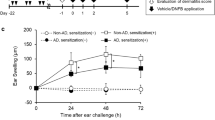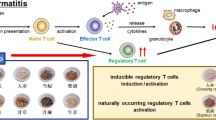Abstract
Atopic dermatitis (AD) is a chronic pruritic inflammatory skin disease that frequently begins at infancy and the majority of them develop asthma and/or allergic rhinitis later, in which food and inhaled allergens play an important role. There is a murine model for AD that is induced by repeated epicutaneous (e.c.) exposure with ovalbumin (OVA). This model shares many characteristic features with AD, including development of asthma as well as dermatitis. Recently, it is reported that ocular tolerance or tolerance induced by intravenous administration of in vitro generated tolerogenic antigen-presenting cells (tol-APC), which can bypasses ocular tolerance, inhibits the immune response in a murine asthma model. The present study was designed to investigate whether tolerance induced by tol-APC and ocular tolerance inhibits AD-like dermatitis induced by repeated e.c. sensitization with OVA. BALB/c mice were given a total of three 1 week e.c. exposures to OVA with 2-week intervals between exposures. After second exposure to OVA, mice received the tol-APC or received OVA in the anterior chamber (AC) of the eye (ocular tolerance). Both groups of mice received the tol-APC and mice that received OVA in the AC of the eye showed weakened cellular infiltration in the skin including eosinophils and mast cells, lower levels of antigen-specific IgE, lower levels of transcripts of IL-4, IL-5, IL-13 in the skin and less production of Th1 and Th2 cytokine by regional lymph node cells, compared with those of mice that received sham treatment and mice that received the tol-APC treated with unrelated antigen after second e.c. exposure to OVA. These results indicate that antigen-specific tolerance induced by the tol-APC and ocular tolerance can inhibit the dermatitis and its related systemic immune response in the murine AD model. These types of tolerance might lead to a new therapeutic approach to allergic skin disease.







Similar content being viewed by others
References
D’Orazio TJ, Mayhew E, Niederkorn JY (2001) Ocular immune privilege promoted by the presentation of peptide on tolerogenic B cells in the spleen. II. Evidence for presentation by Qa-1. J Immunol 166:26–32
Faunce DE, Sonoda KH, Stein-Streilein J (2001) MIP-2 recruits NKT cells to the spleen during tolerance induction. J Immunol 166:313–321
Faunce DE, Terajewicz A, Stein-Streilein J (2004) Cutting edge: in vitro-generated tolerogenic APC induce CD8+ T regulatory cells that can suppress ongoing experimental autoimmune encephalomyelitis. J Immunol 172:1991–1995
Gustafsson D, Sjoberg O, Foucard T (2003) Sensitization to food and airborne allergens in children with atopic dermatitis followed up to 7 years of age. Pediatr Allergy Immunol 14:448–452
Hara Y, Caspi RR, Wiggert B, Chan CC, Wilbanks GA, Streilein JW (1992) Suppression of experimental autoimmune uveitis in mice by induction of anterior chamber-associated immune deviation with interphotoreceptor retinoid-binding protein. J Immunol 148:1685–1692
Herrick CA, Xu L, McKenzie AN, Tigelaar RE, Bottomly K (2003) IL-13 is necessary, not simply sufficient, for epicutaneously induced Th2 responses to soluble protein antigen. J Immunol 170:2488–2495
Holm L, Bengtsson A, van Hage-Hamsten M, Ohman S, Scheynius A (2001) Effectiveness of occlusive bedding in the treatment of atopic dermatitis—a placebo-controlled trial of 12 months’ duration. Allergy 56:152–158
Hu D, Ikizawa K, Lu L, Sanchirico ME, Shinohara ML, Cantor H (2004) Analysis of regulatory CD8 T cells in Qa-1-deficient mice. Nat Immunol 5:516–523
Katagiri K, Itami S, Hatano Y, Takayasu S (1997) Increased levels of IL-13 mRNA, but not IL-4 mRNA, are found in vivo in peripheral blood mononuclear cells (PBMC) of patients with atopic dermatitis (AD). Clin Exp Immunol 108:289–294
Katagiri K, Zhang-Hoover J, Mo JS, Stein-Streilein J, Streilein JW (2002) Using tolerance induced via the anterior chamber of the eye to inhibit Th2-dependent pulmonary pathology. J Immunol 169:84–89
Keino H, Takeuchi M, Kezuka T, Hattori T, Usui M, Taguchi O, Streilein JW, Stein-Streilein J (2006) Induction of eye-derived tolerance does not depend on naturally occurring CD4+CD25+T regulatory cells. Invest Ophthalmol Vis Sci 47:1047–1055
Kosiewicz MM, Alard P, Streilein JW (1998) Alterations in cytokine production following intraocular injection of soluble protein antigen: impairment in IFN-γ and induction of TGF-β and IL-4 production. J Immunol 161:5382–5390
Kosiewicz MM, Streilein JW (1996) Intraocular injection of class II-restricted peptide induces an unexpected population of CD8 regulatory cells. J Immunol 157:1905–1912
Laouini D, Alenius H, Bryce P, Oettgen H, Tsitsikov E, Geha RS (2003) IL-10 is critical for Th2 responses in a murine model of allergic dermatitis. J Clin Invest 112:1058–1066
Lin HH, Faunce DE, Stacey M, Terajewicz A, Nakamura T, Zhang-Hoover J, Kerley M, Mucenski ML, Gordon S, Stein-Streilein J (2005) The macrophage F4/80 receptor is required for the induction of antigen-specific efferent regulatory T cells in peripheral tolerance. J Exp Med 201:1615–1625
Ma W, Bryce PJ, Humbles AA, Laouini D, Yalcindag A, Alenius H, Friend DS, Oettgen HC, Gerard C, Geha RS (2002) CCR3 is essential for skin eosinophilia and airway hyperresponsiveness in a murine model of allergic skin inflammation. J Clin Invest 109:621–628
Masli S, Turpie B, Hecker KH, Streilein JW (2002) Expression of thrombospondin in TGFβ-treated APCs and its relevance to their immune deviation-promoting properties. J Immunol 168:2264–2273
Nakamura T, Sonoda KH, Faunce DE, Gumperz J, Yamamura T, Miyake S, Stein-Streilein J (2003) CD4+ NKT cells, but not conventional CD4+ T cells, are required to generate efferent CD8+ T regulatory cells following antigen inoculation in an immune-privileged site. J Immunol 171:1266–1271
Namba K, Kitaichi N, Nishida T, Taylor A (2002) Induction of regulatory T cells by the immunomodulating cytokines a-melanocyte-stimulating hormone and transforming growth factor-β2. J Leukoc Biol 72:946–952
Ricci G, Patrizi A, Specchia F, Menna L, Bottau P, D’Angelo V, Masi M (2000) Effect of house dust mite avoidance measures in children with atopic dermatitis. Br J Dermatol 143:379–384
Ring J, Darsow U, Behrendt H (2001) Role of aeroallergens in atopic eczema: proof of concept with the atopy patch test. J Am Acad Dermatol 45:S49–S52
Sonoda KH, Exley M, Snapper S, Balk SP, Stein-Streilein J (1999) CD1-reactive natural killer T cells are required for development of systemic tolerance through an immune-privileged site. J Exp Med 190:1215–1226
Sonoda KH, Stein-Streilein J (2002) CD1d on antigen-transporting APC and splenic marginal zone B cells promotes NKT cell-dependent tolerance. Eur J Immunol 32:848–857
Spergel JM, Mizoguchi E, Brewer JP, Martin TR, Bhan AK, Geha RS (1998) Epicutaneous sensitization with protein antigen induces localized allergic dermatitis and hyperresponsiveness to methacholine after single exposure to aerosolized antigen in mice. J Clin Invest 101:1614–1622
Spergel JM, Mizoguchi E, Oettgen H, Bhan AK, Geha RS (1999) Roles of TH1 and TH2 cytokines in a murine model of allergic dermatitis. J Clin Invest 103:1103–1111
Sugita S, Streilein JW (2003) Iris pigment epithelium expressing CD86 (B7–2) directly suppresses T cell activation in vitro via binding to cytotoxic T lymphocyte-associated antigen 4. J Exp Med 198:161–171
Vissers JL, van Esch BC, Hofman GA, van Oosterhout AJ (2005) Macrophages induce an allergen-specific and long-term suppression in a mouse asthma model. Eur Respir J 26:1040–1046
Wang LF, Lin JY, Hsieh KH, Lin RH (1996) Epicutaneous exposure of protein antigen induces a predominant Th2-like response with high IgE production in mice. J Immunol 156:4077–4082
Wang G, Savinko T, Wolff H, Dieu-Nosjean MC, Kemeny L, Homey B, Lauerma AI, Alenius H (2007) Repeated epicutaneous exposures to ovalbumin progressively induce atopic dermatitis-like skin lesions in mice. Clin Exp Allergy 37:151–161
Warner JO (2001) A double-blinded, randomized, placebo-controlled trial of cetirizine in preventing the onset of asthma in children with atopic dermatitis: 18 months’ treatment and 18 months’ posttreatment follow-up. J Allergy Clin Immunol 108:929–937
Wilbanks GA, Mammolenti M, Streilein JW (1991) Studies on the induction of anterior chamber-associated immune deviation (ACAID). II. Eye-derived cells participate in generating blood-borne signals that induce ACAID. J Immunol 146:3018–3024
Wilbanks GA, Mammolenti M, Streilein JW (1992) Studies on the induction of anterior chamber-associated immune deviation (ACAID). III. Induction of ACAID depends upon intraocular transforming growth factor-β. Eur J Immunol 22:165–173
Wilbanks GA, Streilein JW (1990) Characterization of suppressor cells in anterior chamber-associated immune deviation (ACAID) induced by soluble antigen. Evidence of two functionally and phenotypically distinct T-suppressor cell populations. Immunology 71:383–389
Wilbanks GA, Streilein JW (1990) Distinctive humoral immune responses following anterior chamber and intravenous administration of soluble antigen. Evidence for active suppression of IgG2-secreting B lymphocytes. Immunology 71:566–572
Wilbanks GA, Streilein JW (1992) Macrophages capable of inducing anterior chamber associated immune deviation demonstrate spleen-seeking migratory properties. Reg Immunol 4:130–137
Zhang-Hoover J, Finn P, Stein-Streilein J (2005) Modulation of ovalbumin-induced airway inflammation and hyperreactivity by tolerogenic APC. J Immunol 175:7117–7124
Zhang-Hoover J, Stein-Streilein J (2004) Tolerogenic APC generate CD8+ T regulatory cells that modulate pulmonary interstitial fibrosis. J Immunol 172:178–185
Zhu X, Yang P, Zhou H, Li B, Huang X, Meng Q, Wang L, Kijlstra A (2007) CD4+CD25+ Tregs express an increased LAG-3 and CTLA-4 in anterior chamber-associated immune deviation. Graefes Arch Clin Exp Ophthalmol 245:1549–1557
Acknowledgments
This work was supported by a grant from the Kieikai Foundation for Arts and Sciences.
Conflict of interest
The authors state no conflict of interest.
Author information
Authors and Affiliations
Corresponding author
Rights and permissions
About this article
Cite this article
Katagiri, K., Arakawa, S., Hatano, Y. et al. Tolerogenic antigen-presenting cells successfully inhibit atopic dermatitis-like skin lesion induced by repeated epicutaneous exposure to ovalbumin. Arch Dermatol Res 300, 583–593 (2008). https://doi.org/10.1007/s00403-008-0865-y
Received:
Revised:
Accepted:
Published:
Issue Date:
DOI: https://doi.org/10.1007/s00403-008-0865-y




